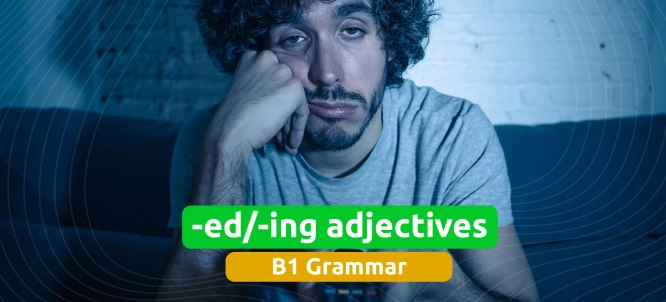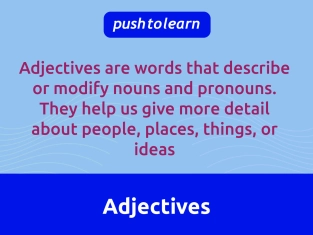by PushtoLearn
-ed/-ing adjectives – Adjectives from verbs
Table of Contents
-ed/-ing adjectives – Exercises
These exercises focus on -ed/-ing adjectives
What Are -ed and -ing Adjectives?
-ed and -ing adjectives come from verbs and are used to describe people, things, or situations.
-
-ed adjectives describe how a person feels.
-
Example: I’m interested in art.
-
-ing adjectives describe the thing or situation that causes the feeling.
-
Example: The art exhibition is interesting.
Differences Between -ed and -ing Adjectives
|
-ed Adjectives |
-ing Adjectives |
|
Describe feelings/emotions of a person |
Describe characteristics of something or someone |
|
Answer the question “How do you feel?” |
Answer the question “What is it like?” |
|
Example: I’m excited. |
Example: The game is exciting. |

Rules for Using -ed and -ing Adjectives
-
-ed Adjectives Describe Feelings:
Use -ed adjectives to show someone’s emotional state. -
She is tired.
-
They are surprised.
-
-ing Adjectives Describe Causes:
Use -ing adjectives to talk about what causes the feeling. -
The job is tiring.
-
The movie is surprising.
-
Adjective Pairs Work Together:
Many verbs form both -ed and -ing adjectives. Here are some common examples:
|
Verb |
-ed Adjective |
-ing Adjective |
|
bore |
bored |
boring |
|
interest |
interested |
interesting |
|
tire |
tired |
tiring |
|
excite |
excited |
exciting |
|
amaze |
amazed |
amazing |
|
annoy |
annoyed |
annoying |
Common Errors
1. Mixing Up -ed and -ing Adjectives
-
❌ I’m boring in the class.
-
✅ I’m bored in the class.
(The person feels bored; the class is boring.) -
❌ The dog is excited to play, it’s an exciting dog.
-
✅ The dog is excited to play, it’s an energetic dog.
(The dog is not always exciting; its personality is energetic.)
2. Using -ed Adjectives for Non-People Subjects
-
❌ The book is bored.
-
✅ The book is boring.
*(The book cannot feel bored.)
3. Forgetting Context
-
❌ I feel amazing about the problem.
-
✅ I feel amazed about the solution.
*(“Amazing” describes the thing, not the feeling.)
Everyday Use of -ed and -ing Adjectives
Here are some sentences to show how to use these adjectives in daily life:
-
Describing your feelings:
-
I’m confused by the instructions.
-
He was embarrassed during the meeting.
-
Talking about causes:
-
The instructions are confusing.
-
The meeting was embarrassing.
-
Combining both:
-
I was amazed by the amazing fireworks show.
-
She is annoyed by the annoying noise.
FAQ About -ed/-ing Adjectives
What’s the easiest way to remember the difference?
Use this trick: -ed = emotions (feelings), -ing = information (causes).
Can we use -ed adjectives for objects?
No, -ed adjectives describe feelings, which only people (or animals) experience.
Can one verb have both -ed and -ing adjectives?
Yes, many verbs form both types, like excited/exciting or tired/tiring.
Why do some -ing adjectives seem permanent?
Some -ing adjectives describe characteristics, e.g., "an amazing person," instead of temporary feelings.
What are common -ed/-ing adjective mistakes?
The most common mistake is mixing up feelings with causes, like saying "I’m boring" instead of "I’m bored."

